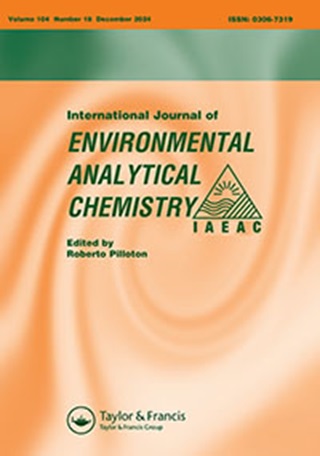Comparative study on the role of single- and double-cathode in electro-Fenton process for treatment of Reactive Orange 16 dye bearing wastewaters
IF 2.5
4区 化学
Q3 CHEMISTRY, ANALYTICAL
International Journal of Environmental Analytical Chemistry
Pub Date : 2023-10-15
DOI:10.1080/03067319.2023.2264786
引用次数: 0
Abstract
ABSTRACTThe study presents the single- and dual-cathode electro-Fenton (DCEF) treatment of the Reactive Orange 16 (RO16) azo dye-bearing synthetic wastewater. Initially, the effect of operational parameters, i.e. initial [RO16] dye, [Fe+2] iron catalyst, [NaCl] electrolyte, operational pH, and current density (ρ), on the performance of the electro-Fenton (EF) process was evaluated with the application of low-cost stainless steel (SS) electrodes. At the optimum condition ([RO16] = 150 mg/L, [Fe+2] = 0.4 mM/L, [NaCl] = 0.4 M/L, pH = 3.5, ρ = 20 mA/cm2), with a total electrolysis time of 40 min, the colour (RD) and COD (RC) removals were observed to be 92.023% and 83.344%, respectively. Further, the process was upgraded by providing an additional activated graphite plate (AGP) cathode (dual cathodes), and the results indicated a significant reduction (40 min to 25 min) in the electrolysis time, with a drop in electrical energy (2.51 kW/m3 to 1.47 kW/m3). This consequently reduced the operational cost ($3.42/m3 to $1.23/m3) of the lab-scale DCEF process. The XPS analysis showed enhancement in H2O2 concentration at the surface of the additional AGP cathode. The cyclic voltammetry (CV) test confirmed the complete mineralisation of RO16 dye and the formation of intermediate products. The insight mechanism of the conventional and upgraded processes was also explored for the generated sludge and formed products using FTIR and quantum chemical (QC) analysis. The results showed that the DCEF process was highly efficient, low-cost, and an environmentally compatible technology for the treatment of dye-bearing industrial effluents.KEYWORDS: Electro-Fenton processdouble-cathode applicationactivated graphite plateXPS-analysiscyclic voltammetryquantum chemistry AcknowledgmentsThe authors appreciate the Civil Engineering Department, Motilal Nehru National Institute of Technology Allahabad, for providing the laboratory facility.Disclosure statementNo potential conflict of interest was reported by the author(s).Authors’ contributionsImran Ahmad: Conceptualisation, Data curation, Formal analysis, Investigation, Methodology, Project administration, Software, Validation, Visualisation, Writing – Original draft. Debolina Basu: Conceptualisation, Supervision, Reviewing, and Editing.Data availability statementAll data generated or analysed in the current study are included in the manuscript.电fenton法处理活性橙16染料废水中单、双阴极作用的比较研究
摘要研究了单、双阴极电fenton (DCEF)处理活性橙16 (RO16)偶氮染料合成废水。首先,通过应用低成本不锈钢(SS)电极,评估了初始[RO16]染料、[Fe+2]铁催化剂、[NaCl]电解质、操作pH和电流密度(ρ)对电fenton (EF)工艺性能的影响。在最佳电解条件([RO16] = 150 mg/L, [Fe+2] = 0.4 mM/L, [NaCl] = 0.4 M/L, pH = 3.5, ρ = 20 mA/cm2)下,总电解时间为40 min,颜色(RD)和COD (RC)去除率分别为92.023%和83.344%。此外,通过提供额外的活化石墨板(AGP)阴极(双阴极),该工艺得到了升级,结果表明,电解时间显著缩短(40分钟至25分钟),电能下降(2.51 kW/m3至1.47 kW/m3)。因此,这降低了实验室规模DCEF工艺的运营成本(3.42美元/立方米至1.23美元/立方米)。XPS分析表明,附加的AGP阴极表面H2O2浓度增强。循环伏安(CV)试验证实了RO16染料的完全矿化和中间产物的形成。利用FTIR和量子化学(QC)分析,探讨了传统工艺和升级工艺对产生的污泥和形成的产物的洞察机制。结果表明,DCEF工艺是一种高效、低成本、环保的染料工业废水处理技术。关键词:电fenton工艺双阴极应用活性石墨平台电化学分析循环伏安法量子化学致谢作者感谢阿拉哈巴德尼赫鲁国立理工学院土木工程系提供的实验室设施。披露声明作者未报告潜在的利益冲突。作者贡献:simran Ahmad:概念化,数据管理,形式分析,调查,方法论,项目管理,软件,验证,可视化,写作-原稿。Debolina Basu:概念,监督,审查和编辑。数据可用性声明当前研究中产生或分析的所有数据都包含在手稿中。
本文章由计算机程序翻译,如有差异,请以英文原文为准。
求助全文
约1分钟内获得全文
求助全文
来源期刊
CiteScore
5.90
自引率
7.70%
发文量
373
审稿时长
4.4 months
期刊介绍:
International Journal of Environmental Analytical Chemistry comprises original research on all aspects of analytical work related to environmental problems. This includes analysis of organic, inorganic and radioactive pollutants in air, water, sediments and biota; and determination of harmful substances, including analytical methods for the investigation of chemical or metabolic breakdown patterns in the environment and in biological samples.
The journal also covers the development of new analytical methods or improvement of existing ones useful for the control and investigation of pollutants or trace amounts of naturally occurring active chemicals in all environmental compartments. Development, modification and automation of instruments and techniques with potential in environment sciences are also part of the journal.
Case studies are also considered, particularly for areas where information is scarce or lacking, providing that reported data is significant and representative, either spatially or temporally, and quality assured. Owing to the interdisciplinary nature of this journal, it will also include topics of interest to researchers in the fields of medical science (health sciences), toxicology, forensic sciences, oceanography, food sciences, biological sciences and other fields that, in one way or another, contribute to the knowledge of our environment and have to make use of analytical chemistry for this purpose.

 求助内容:
求助内容: 应助结果提醒方式:
应助结果提醒方式:


